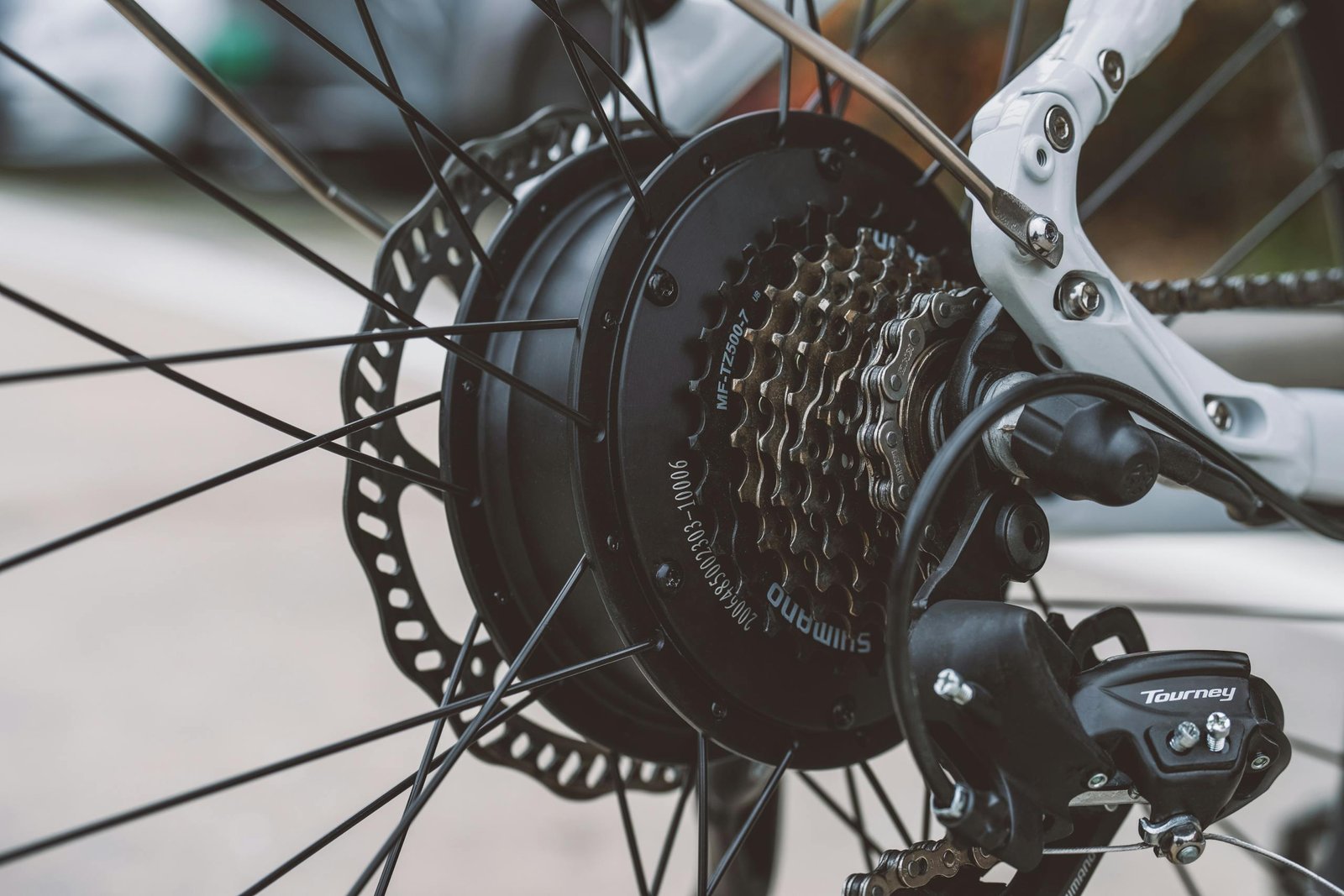The Ultimate Guide to Electric Bike Motors: Everything You Need to Know (2024)
I’ve always wanted to do an article on The Ultimate Guide to Electric Bike Motors. Ever wondered how electric bike motors actually work? You’re not alone! The technology behind e-bike motors is interesting to say the least – imagine a device smaller than a football that can propel you up steep hills with ease.
As an e-bike owner, I’ve seen the technology evolve dramatically over the past few years. In fact, modern e-bike motors are 35% more efficient than models from just five years ago! Let’s demystify these different types and see what makes them tick.
The Basic Principles Behind E-Bike Motors
Let’s talk e bike motors – something I’ve gotten pretty obsessed with since getting my first e-bike three years ago. It’s amazing how these things work, and trust me, I’ve learned a ton from taking mine apart (probably more times than I should have!).

You know what’s crazy? The basic principle behind e-bike motors is actually pretty simple, even though I totally messed up understanding it at first. It all comes down to electromagnets and permanent magnets playing a carefully orchestrated dance. When electricity flows through copper coils inside the motor, it creates electromagnetic fields that interact with permanent magnets, causing rotation.
Different Types of E-Bike Motors
Let me break down the two main types of motors you’ll see out there, because this confused the heck out of me when I was first shopping for an e-bike. Hub motors, which sit right in the wheel, are like the OG of e-bike motors. They’re these chunky things that replace your regular bike hub – I’ve got one on my folding e-bike.
Then there’s mid-drive motors, which sit at the pedals (technically called the bottom bracket). These are the fancy ones that serious riders tend to prefer. Each type has its pros and cons, but I’ve found hub motors are great for casual riders while mid-drives really shine on hilly terrain.
The Brain of the System: Motor Controllers
The real magic happens in the controller – think of it as the motor’s brain. It’s constantly monitoring stuff like how hard you’re pedaling, what speed you’re going, and how much juice is left in the battery.
The controller takes all this information and decides exactly how much power to send to the motor at any given moment. It’s pretty incredible how it can make thousands of tiny adjustments every second to give you the perfect riding experience.
Energy Conversion and Efficiency
Here’s something cool about the energy conversion that most people don’t realize: these motors are actually super efficient. We’re talking 80-90% efficient at turning electrical energy into mechanical energy. That’s way better than a car engine!
The motor takes DC power from your battery and converts it into mechanical rotation through those electromagnetic fields I mentioned earlier. It’s a beautiful symphony of electrical and mechanical energy working together.
Understanding Pedal Assist Systems
The pedal assist system is probably my favorite part to geek out about. There’s these cool little sensors that can tell how hard you’re pushing on the pedals. Some bikes use a basic cadence sensor (just measures if you’re pedaling or not), but the better ones use torque sensors.
Man, the difference between these two is like night and day – torque sensors make the whole riding experience feel so much more natural. It’s like the bike knows exactly when you need that extra boost. My e-bike hits up to 28 MPH on pedal assist.

Advanced Features: Regenerative Braking
One thing that really surprised me was how the motor can actually help preserve your battery life when you’re going downhill. Through a process called regenerative braking (though not all e-bikes have this), the motor can actually work in reverse, acting as a generator to recharge the battery a tiny bit.
I’ve found that understanding how these systems work together has made me a much better e-bike owner. When something’s not working quite right, I usually have a pretty good idea of where to start looking.
The coolest part is that the technology keeps getting better every year. The motors are getting smaller, more powerful, and more efficient. It’s pretty exciting to see where this is all headed. Just remember – at the end of the day, it’s still a bike, just with some really clever engineering to give you a boost when you need it.
Types of E-Bike Motors Explained
Mid-Drive Motors: The Powerhouse Option
I remember when I first started learning about e-bike motors – man, was I confused! But after spending countless hours working with different types, mid-drive motors really stand out as something special. They sit right at the bike’s cranks (that’s the pedal area), and let me tell you, the way they work is pretty cool.
The coolest thing about mid-drives is how they use your bike’s existing gears. These motors can spin at their optimal RPM while you’re in the perfect gear for the situation.

Hub Motors: The Reliable Workhorses
Now, let’s talk about hub motors – they’re like the trusty old pickup truck of the e-bike world. I’ve got one on my folding e-bike, and it’s been running strong for years. These workhorses sit right in the center of either your front or rear wheel (though rear is way more common, trust me on this one).

There’s something satisfying about how simple hub motors are. No extra chains or gears to worry about – the motor just spins the wheel directly. Sure, they might not be as fancy as mid-drives, but for cruising around town or commuting, they’re honestly perfect.
Understanding Friction Drive Systems
Okay, here’s one that might surprise you – friction drives! These are like the underdogs of the e-bike world. They work by literally pressing a powered roller against your tire. They’re super simple mechanically, but they can struggle in wet weather.
Geared vs Direct Drive: The Great Debate
Here’s where things get really interesting – the difference between geared and direct drive motors. I used to think all hub motors were the same until I rode both types back-to-back. Geared motors have these little planetary gears inside that let the motor spin faster while keeping the wheel speed normal. They’re lighter and usually more efficient at lower speeds.
Direct drive motors, on the other hand, are like one solid piece – no gears at all. They’re basically bulletproof reliable, which is why you see them on a lot of rental bikes. The trade-off? They’re usually heavier and can drag a bit when you’re pedaling without power.
Picking the Right Motor Type
After years of tinkering with different setups, I’ve learned that choosing the right motor really depends on how you plan to use your bike. Here’s what I’ve figured out:
Mid-drives are awesome if you:
- Ride lots of hills
- Want the most natural biking feel
- Like to ride long distances
- Need good range from your battery
Hub motors might be better if you:
- Mostly ride on flat terrain
- Want something super reliable
- Don’t want to think about shifting gears
- Are working with a tighter budget
The funny thing is, every time I think I’ve settled on my “perfect” motor type, I ride something new that makes me question everything! But that’s what makes this whole e-bike world so exciting – there’s always something new to learn and experience.
Just keep in mind that any motor type can work great if it matches your riding style. The best motor is the one that gets you out riding more!
Remember though – whatever motor type you choose, regular maintenance is key. I made the mistake of ignoring some weird noises once… let’s just say they didn’t go away on it’s own!

Key Components of E-Bike Motors
Hall Sensors: The Motor’s Eyes
These little sensors are constantly sending signals to the controller, hundreds of times per second. Without them, the motor would be totally out of sync.
The Brain: Controller Systems
The controller is where all the real magic happens! Think of it as the motor’s brain – it’s constantly processing information and making split-second decisions.
Gear Reduction: Making Sense of Speed
In geared hub motors, you’ve got these tiny planetary gears that let the motor spin super fast (where it’s most efficient) while keeping your wheel speed just right.
Mid-drive motors use a different approach, working with your bike’s existing gears. It’s pretty cool how they can multiply the motor’s torque through the bike’s gearing system.
Keeping Cool: Motor Cooling Systems
E-bike motors generate heat. Some motors use simple passive cooling with fins on the housing, while others have more sophisticated systems.
The real fancy ones even have temperature sensors that reduce power automatically if things get too hot.
Understanding Torque and Cadence Sensors
Now this is something worth knowing about – the difference between torque and cadence sensors. Cadence sensors are pretty basic – they just detect if you’re pedaling or not. But torque sensors? Measure exactly how hard you’re pushing those pedals.
These sensors work together with the controller to create “pedal assist levels.” Think of it like having different gears for your motor’s power.

Understanding Motor Power Ratings
What Do Watts Really Mean?
Let me tell you about watts – and no, I’m not talking about California! Think of watts like horsepower for your e-bike. The higher the number, the more oomph you’ve got.
Nominal vs Peak Power: The Real Story
Nominal power is like your motor’s cruising speed, while peak power is its sprint capacity. Think of it like running – you can sprint for a short burst, but you can jog for hours.
All About Torque
Torque is measured in Newton meters (Nm), and it’s what gives you that initial push, especially when starting from a stop or climbing hills. My mid-drive bike puts out about 75Nm of torque, and let me tell you – it makes those hill starts feel like you’ve got Lance Armstrong’s legs!
Voltage Systems Explained
The whole voltage thing confused the heck out of me at first. I mean, 36V, 48V, 52V – what’s the deal? After diving deep into the tech, I finally got it. Higher voltage systems generally give you better performance and efficiency.
Think of voltage like water pressure in a pipe. Higher voltage means the electrical “pressure” is higher, which can help deliver power more efficiently.
Reading Motor Specs Like a Pro
A well-designed 350W motor might perform better than a cheap 500W one. Here’s what I’ve learned to look for:
- Nominal power (for sustained performance)
- Peak power
- Torque rating (especially important for hills)
- Voltage system (higher generally means better performance)
- Motor efficiency rating (affects your range)

Navigating Power Restrictions
Here’s something that caught me off guard – different places have different rules about how powerful your e-bike can be. In Europe, they cap most e-bikes at 250W, while parts of the US allow up to 750W. Some places even let you go higher!
The trick is understanding that these limits usually refer to nominal power, not peak power.
The most important thing I’ve learned is you don’t always need the highest-powered motor available.
Remember, the best power rating is the one that matches your riding style and terrain. And trust me on this – no matter what power rating you choose, you’ll still get a workout if you want one. These motors are helpers, not motorcycles in disguise!
Motor Efficiency and Performance Factors
Power Consumption Analysis
One of the key factors affecting e-bike performance is the efficiency of the motor. A more efficient motor requires less energy to produce the same amount of power, extending your battery life and overall riding range.
Mechanical Losses Explained
Mechanical losses, such as friction in the motor bearings and gear train, can reduce overall efficiency. Well-lubricated components can minimize these losses. It’s similar to ensuring your bike chain is well-oiled to reduce friction and improve pedaling efficiency.
Impact of Terrain and Riding Style
The terrain you’re riding on and your riding style can significantly affect motor performance and battery life. Hilly terrain demands more power, while flat roads are easier on the motor. Aggressive riding styles, with frequent acceleration and braking, can drain the battery faster. It’s like driving a car; aggressive driving consumes more fuel, while a gentle driving style can improve fuel economy.
Weather Effects on Performance
Weather conditions can influence e-bike performance. Extreme cold can reduce battery capacity and motor efficiency, while extreme heat can increase heat generation.
Battery-Motor Relationship
The battery and motor are closely intertwined. A powerful battery can provide ample energy for the motor, but it’s important to match the battery’s capacity to the motor’s power requirements.
Common Motor Technologies and Features
Pedal Assist Technology (PAS)
Pedal assist is a popular feature that provides varying levels of electric motor support based on your pedaling input. It’s like having a personal trainer who boosts your effort when you need it most. This technology makes riding easier, especially on hills or when carrying heavy loads.
Throttle Control Systems

A throttle allows you to control the motor’s power output independently of pedaling. It’s similar to a motorcycle throttle, giving you instant acceleration. While convenient, relying too heavily on the throttle can drain the battery faster.
Regenerative Braking Capabilities
Regenerative braking captures energy during braking and converts it into electricity, which is stored in the battery. This extends your battery life and adds a unique feel to the braking experience. It’s like charging your phone while you’re using it.
Smart Motor Features
Smart motors use advanced sensors and algorithms to optimize performance and efficiency. They can automatically adjust power output based on factors like terrain, speed, and battery level. It’s like having a smart assistant that anticipates your needs.
Bluetooth Connectivity
Bluetooth connectivity allows you to pair your e-bike with a smartphone app. This enables you to monitor various parameters like battery level, speed, and distance traveled. Some apps even offer custom settings and firmware updates. It’s like having a digital dashboard for your bike.
Motor Programming Options
Some e-bikes offer motor programming options, allowing you to customize the motor’s behavior. You can adjust parameters like maximum power output, pedal assist levels, and regenerative braking strength. It’s like tuning a car to your specific preferences.
Final Thoughts
Understanding e-bike motors doesn’t have to be complicated! Now that you grasp the fundamentals of how these amazing machines work, you’ll be better equipped to maintain your e-bike and make informed decisions about future purchases. Remember, the beauty of e-bike motors lies in their ability to enhance your riding experience while remaining remarkably reliable.
Engage, Endure and Enjoy!
Find More Resources on Bicycles
- Smart Bike Trainers: 2024 Best Picks with Features and Benefits
- Mountain Biking for Beginners: Essential Guide to Hit the Trails in 2024
- 3 Best Mountain Bikes of 2024: Complete Buyer’s Guide & Reviews
- How Do You Adjust Bike Brakes? A Step-by-Step Guide for 2024
- Essential Mountain Bike Gear: A Complete Guide for 2024







